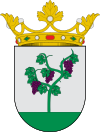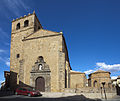Ágreda
| Ágreda municipality | ||
|---|---|---|
 Ágreda - town view
|
||
| coat of arms | Map of Spain | |

|
|
|
| Basic data | ||
| Autonomous Community : |
|
|
| Province : | Soria | |
| Comarca : | Moncayo | |
| Coordinates | 41 ° 51 ′ N , 1 ° 55 ′ W | |
| Height : | 930 msnm | |
| Area : | 164.93 km² | |
| Residents : | 3,001 (Jan. 1, 2019) | |
| Population density : | 18.2 inhabitants / km² | |
| Postal code : | 42100 | |
| Municipality number ( INE ): | 42004 | |
| administration | ||
| Website : | Ágreda | |
Ágreda is a small town and a Spanish municipality ( municipio ) with 3,001 inhabitants (as of January 1, 2019) in the province of Soria in the autonomous community of Castile and León . The old town of Ágreda was classified as Conjunto histórico-artístico in 1975 ; In parts, the place is reminiscent of a mountain oasis with terraced fields and small plots.
Location and climate
The small town of Ágreda is located on the road between Soria and Pamplona in the extreme north of the Soria province near the border with the autonomous region of La Rioja at an altitude of about 930 m . The provincial capital Soria is about 50 km (driving distance) in a south-westerly direction. The climate is harsh, sometimes temperate to warm; Rain (approx. 555 mm / year) falls over the year.
Population development
| year | 1857 | 1900 | 1950 | 2000 | 2017 |
| Residents | 3,179 | 3.210 | 3,525 | 3,260 | 2,993 |
Ágreda is one of the few mountain towns in the province of Soria with growing or only slightly decreasing population.
economy
Ágreda is the economic and cultural center in the mainly agricultural north-east of the province of Soria. Farmers, craftsmen, traders and service providers of all kinds have settled here since time immemorial. Since the last decades of the 20th century, tourism has played an increasingly important role in the economic life of the small town.
history
There was a Celtiberian settlement in the area of the present city ; Romans and Visigoths , however, left no archaeological traces recyclable, but km southwest to the city about 8 were Muro de Ágreda nearby wall remains unique as a Roman city Augustobriga identified. In the 8th century, the Moors penetrated into the region; Ágreda became an important center of Islamic culture. In 1119 King Alfonso I of Aragon recaptured the area ( reconquista ) , but in 1135 it was conquered by Alfonso VII for the Kingdom of Castile . Ágreda gained importance as a border town between the kingdoms of Castile and Aragon as well as an important center for arts and crafts, where Christians, Muslims and Jews lived in peace for a long time, which is why Ágreda is also known as the "City of Three Cultures".
Attractions
- Moorish city wall with Puerta árabe
- The "Torreón de la Muela" standing on the outskirts dates from the time of the caliphate (9th / 10th centuries); it was changed in the Middle Ages and partially redesigned in a modern way at the end of the 20th century.
- The church of San Miguel , built in the late Gothic style of the 15th century, is dedicated to the Archangel Michael ; it still has a Romanesque tower from the 12th century. The Plateresque altarpiece from the 16th century is well worth seeing - a commissioned work for the archpriest of Ágreda, Garcia Fernández de Carrascón (approx. 1480–1533), whose imposing tomb is in a side chapel.
- The Virgen de la Peña church was built in the 12th and 13th centuries. Built in the 16th century and extended by two chapels in the 16th century. Today it houses a museum for sacred art.
- The Basilica of Nuestra Señora de los Milagros was rebuilt in the 16th century on the site of a demolished Romanesque church. The nave is spanned by a star vault in the late Gothic style. A Romanesque font still comes from the old church.
- La Concepción Monastery was founded in the 18th century; it houses the relics of María de Jesús .
- A small Romanesque church rises above a former synagogue .
- The palace Los Castejones dates from the 17th century; attached is a beautiful garden.
dto., Romanesque font
Personalities
- Doctor Don Garcia Fernández de Carrascón (approx. 1480–1533), priest and doctor of Pope Hadrian VI. , Archpriest of Ágreda, Apostolic Protonotary , Chamberlain at the Cathedral of Tarazona and Canon of the Cathedral of Toledo
- The abbess Sr. María de Jesús (1602–1665) was born in Ágreda, where she lived all her life. Shortly after her death in 1665, the Catholic Church made her a venerable servant of God . María de Jesús was an advisor to King Philip IV in lifelong correspondence. Over 600 of these letters have survived.
- María Jesús Ruiz Ruiz (* 1960), former mayor of Ágreda and Vice-President of the Government of Castile-León
- Fermín Cacho (* 1969), athlete and Olympic champion in the 1500 m run in Barcelona in 1992
Web links
- Ágreda, sights - photos and information (Spanish)
- Romanesque churches in Ágreda and the surrounding area - photos and information (arteguias, Spanish)
Individual evidence
- ↑ Cifras oficiales de población resultantes de la revisión del Padrón municipal a 1 de enero . Population statistics from the Instituto Nacional de Estadística (population update).
- ↑ Ágreda - climate tables
- ↑ Ágreda - population development










